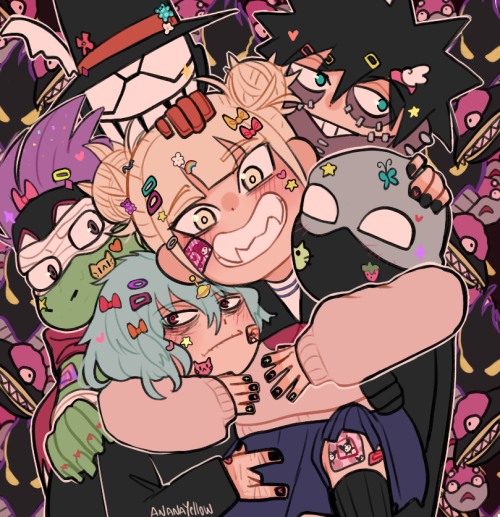
437 posts
Latest Posts by tessrry - Page 4

for some people who may want another access and other arts that I didin’t post over here go to my twitter. lately I’m more active over there.
my twitter << HERE
Sidenote on my tags on my last reblog, but I also wonder if the open front on Dabi's new outfit isn't also meant to invoke seppuku imagery, the samurai ritual suicide
What made me think of this is the fact that Horikoshi clearly gave some thought to how much of Dabi's chest to expose, cause the preliminary design didn't show a lot of skin (notice the version on the left, which is clearly reminiscent of burial clothes, or 死装束 in japanese):


The right side is crossed over the left, in typical fashion for funeral ceremonies. Normally, you wear a yukata or a kimono with the left over the right, as only the dead are dressed the other way around. Dabi's outfit is then supposed to bring to mind the way you'd dress up a corpse for the last rites before a burial.
However, Horikoshi discarded this more "proper" look for what we as a fandom called the "yassiefied" version, with an open, bare chest:



Which honestly brings to mind the aforementioned seppuku ritual.
I know that Dabi is no samurai and that he normally likes loose and low cut clothes, but the fact that his burial-clothes-inspired shroud is specifically open all the way down to his belly seems too deliberate to be coincidence, or something thrown in for fanservice alone, especially considering how the design wasn't originally meant to be... Slutty, for lack of a better term.
So I guess that what I'm saying is: since Dabi went into this war with the intention of committing murder-suicide, it wouldn't surprise me if his outfit too was meant to invoke that duality: that is, the idea that he's both someone already dead (and whom his family mourned and buried), but also someone ready to take his own life to correct a wrong
Idk, just some food for thought
“shigaraki should find twice and give the healing quirk to him” “shigaraki should wake up and give the healing quirk to mr compress” is the lov version of a broke friend group passing around the same $5


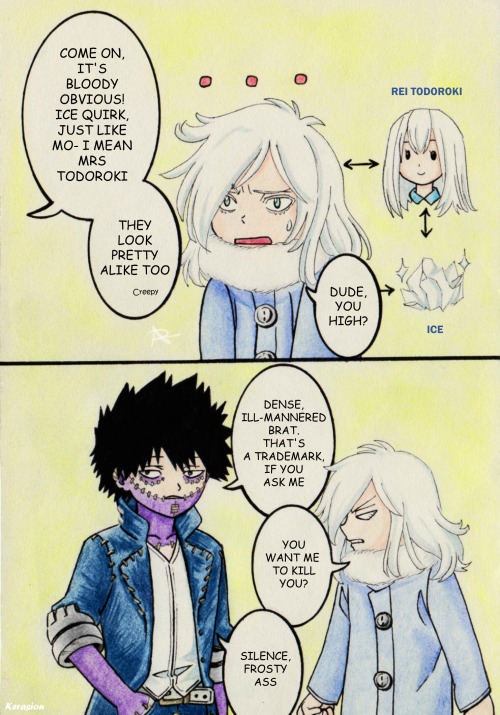




Is Dabi Touya Todoroki or is it maybe Geten? Let’s see what they say
This silly idea is what I came up with after I found out about the “Geten is Touya” crack theory :’)
Do not repost
i actually didnt think it could get worse but touya's reveal being the thing that brought the todorokis together and finally made them ally themselves with endeavour regardless of all the trauma he caused them and how impossible they've found it to even hang out together as a family for the entire decade touya has been gone. THAT being what binds them. they might as well have spat in the face of touya's memory. it's not even an acknowledgement that dabi must be stopped it's just like they never even loved him. endeavour is giving him more sympathy than them. 'you will have to fight dabi one day' et tu rei?

happy whatever
my art
my sister's character Amateru
MHA Spinner, Twice, and Dabi
man, I am never on here anymore I always forget about this platform
We don’t make enough jokes about the fact that Tomura has three whole ass adopted father figures fighting for his custody and Dabi can’t even get a hold of his biological father.

every family has its traditions
todoroki family drama but make it an HBO show
i love him that’s why i need to see him tortured to within an inch of his life covered in his own blood and tears

we can't see Spinner's left hand and Shigaraki's right hand. they're secretly holding hands.

''we got along...*more than i thought* '' WHAT DOES THAT MEAN
HORIKOSHI EXPLAIN
'' *MORE THAN I THOUGHT* '' ???? WHAT DID YOU GUYS KISS OR SOME SHIT TELL ME
Bnha heroes vs villains honest trailer (parody) part 2
Dabi-obviously-not-touya-todoroki, a villain that wants to follow stains will in destroying fake heroes and their place in hero society-

-while listening to every "fXck you dad" song on his way to the hairdresser for all the essentials, because everyone wants to look great on their special day.

Toga Himiko, the evolutionary endpoint of all love obsessed schoolgirls and cosplayers-

-her greatest deception in convincing others that she's just that, instead of a girl driven to madness by her own power and society's rejection.

Also due to the fact that she’s mostly only able to communicate through romantic one-liners.

Together they'll confront the heroes and the heroes will face them, all trying to reconcile their world views while beating the shXt out of each other.
Though Deku spends most of the final War in a Beach Day episode.

And Shigaraki spends it posing like he's a dragon ball z villain.

But taking hits like he's Krillin.

Then the Todoroki brothers face off in a battle of hot vs hot/cold/extras.

Before the whole family gets involved in the fight like it's a reality TV show.

That'll be one awkward family dinner.

And finally, toga vs Ochako takes the series into full Shojo territory, complete with dramatic proclamations and the resulting stabbings-

-resolving in heartfelt confessions and floating light bubbles.

Are there romantic implications when the villain says that blood is her romance, and the hero replies that she'll give her own blood to them for the rest of her life?

Hmmmmm???
So strap in, for a story about conflicting ideals and standards of living, in a world ruled by power and oppression.

Where all of that will fly clear over a lot of people's heads, because the setting doesn't look like a futuristic dystopian landscape ruled by an uncaring well-dressed government that has its children fight for the benefit and entertainment of their society...

Even though it actually kind of does.


Well as long as none of the kids ever get killed, it's not really-

Oh...
Starring:
Memories spoken; no bones left unbroken!

Every-time we touch, you get to crumbling!

Sans the skeleton

We're halfway there!

The red means I love you!

And Utena Rizzako

Too cool for hero school
(Left out the closing line, does anyone have any ideas?)
so the heteromorph discrimination plotline had seemed to explode into the manga with Chapter 370 when the story switched battles to the site of Central Hospital where Spinner is leading disgruntled heteromorphs to retrieve Kurogiri;
though the story did hint it would be addressed since Chapter 310 when Ordinary Woman (big heteromorph gal) was attacked by civilians because they didn’t like they was she looked;
and the first time we got confirmation that such prejudice exists in the HeroAca world was Chapter 220, when the League massacres a bunch of CRC bigots and Spinner’s backstory was revealed (that he suffered through such discrimination all his life and was finally motivated to do something about suffocating in the pervasive heteromorphobic hostile environment - among other things - when he saw Stain on TV);
but I think the story did well to hint at this issue throughout the manga in the background. I would say the first ever hint we get is all the way in Chapter 5, when Deku arrived on his first day at UA and noticed his classroom door was huge:

Has to be accessible to everyone, he says, and that greatly stood out to me.
Because, see, heteromorphic discrimination isn't just judging people by their looks - which is often the go-to discrimination allegory fiction uses, usually based on the irl social construction of race and the issue of racism; nor is it being prejudiced against people with superpowers, because this is a world where 80% of the population have a superpower and having a quirk is accepted (in fact, not having a quirk is considered strange and unusual); rather, heteromorphic discrimination in the HeroAca World takes elements from, yeah, racism, but also ableism.
In this world, quirks gives people a wide, wide diversity of appearances - different body sizes, shapes, anatomy, functions. And different people have different needs. Someone with a quirk that gives them a tail would need a hole cut into their pants so their tail can go through and they can actually wear the pants. Someone who's really, really tall - whether because they have a giraffe neck quirk or just a big body size quirk - would need buildings to have doors that fit them.
How is this ableism? Well, one big issue in disability rights is accommodation. As wikipedia puts it:
Disability discrimination, which treats non-disabled individuals as the standard of 'normal living', results in public and private places and services, educational settings, and social services that are built to serve 'standard' people, thereby excluding those with various disabilities.
A wheelchair user can't go up steps. An event that communicates only through talking would not allow deaf people to participate fully. A world where only abled-bodied people can travel, can communicate, can exist is one that excludes disabled people, preventing them from being full members of their community, and this is the definition of discrimination.
Heteromorphs and people with body-altering quirks in HeroAca world aren't disabled. However, they do have atypical bodies and sometimes unique requirements to live regularly as anyone else. If this impedes their daily functioning, then they would have what can be classified as an impairment. If that impairment causes them to face a barrier that stops them from interacting with other people and the larger outside world, then it can be classified as a disability.
This fluid nature of what can be classified as an impairment or disability means depending on the situation, an able-bodied person can technically experience barriers similar to what disabled people experience.
This is the social model of disability. That
the origins of disability [are] the mental attitudes and physical structures of society, rather than a medical condition faced by an individual...
the most significant barrier for individuals with disabilities is not the disability itself; rather the most significant barrier is the environment in which a person with a disability must interact. Society disables people, through designing everything to meet the needs of the majority of people who are not disabled.
So, if someone with lots of limbs and appendages can't find clothes that fit them, they cannot go outside without violating public decency laws. If someone who's really big can't fit through a standard door and enter buildings, they're effectively blocked from going to school, public transportation, work, etc. This is best illustrated and pointed out explicitly by Kamayan, a character with a giant mantis quirk:
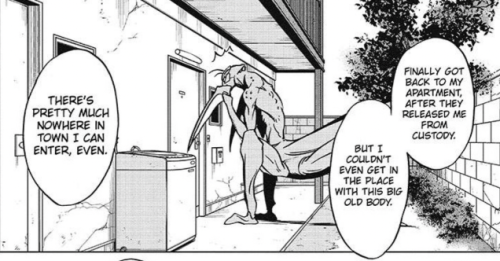
He's from Vigilantes, but the problem he faces is something Horikoshi has already considered, hence the panel from Chapter 5 above.
In fact, Mt. Lady also faced this problem in Chapter 1, when she is unable to fight a Villain and save Bakugou because she's unable to enter a street:

Luckily for Mt. Lady, her quirk allows her to shrink to normal size. But imagine if she was just big like that always. She would be unable to go anywhere. There probably is a quirk out there that is just that: makes someone big, all the time.
These quirks are individual issues. They can technically be viewed as a personal problem, and if the person is unhappy with their situation, then it's up to them to get it 'fixed'. However, that sort of defeats the purpose of having a quirk and accepting that this world is one where everyone has a quirk and should be allowed to exist as they are. Plus, heteromorphs are a significant portion of society.
Rather than telling people whose quirks makes them super tall to stay home - and this would be exclusion and discrimination - why not just build bigger doors and buildings? UA does this, and they're in the right. However, as Kamayan and Mt. Lady (Big Mode) shows, there are still places that don't do this. As Kamayan notes:
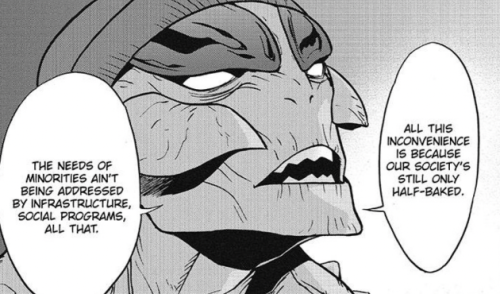
All the way in the beginning of the story in Chapter 5, the issue of accessibility in regards to atypical bodies. Because heteromorphs are people who have atypical bodies, they are most likely to face issues of accommodations. If they do, and they are unable to live well under the current status quo, then yeah, what they go through would be discrimination. Most heteromorphs we see in the series seem to be getting by okay, but it's easy to imagine that they can and have faced barriers because of their body-altering quirks:
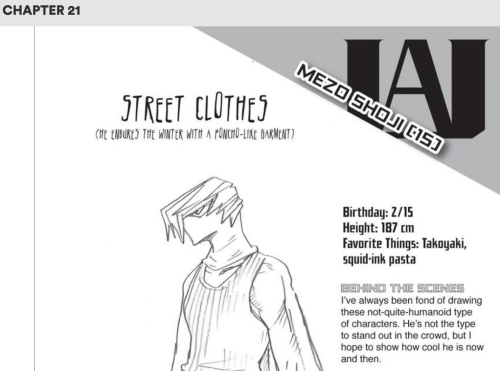
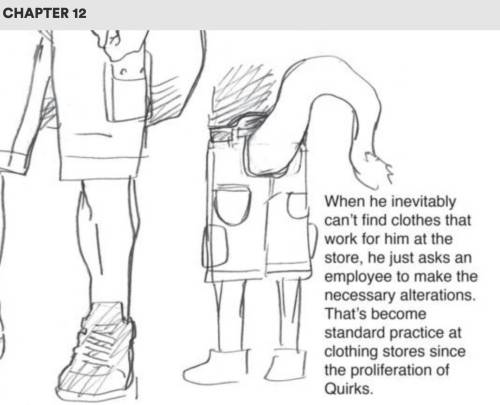
Ojiro requires his clothes to be altered. Shoji is apparently unable to wear a coat, and needs a poncho-like garment in cold weather. These aren't big issues because as Ojiro's profile states: "altering clothing have become standard practice at clothing stores", but a store can also easily just refuse to do so. A store can refuse to serve heteromorph customers because they find tailoring annoying. They don't need to hate and insult heteromorphs for it to be discrimination; they just have to not care.
(does it also cause more money, to ask for alterations? Is it something that gives heteromorphs financial issues, if they need different enough accommodations?)
However, often when a minority bring up an issue they face to the majority and suggest addressing it, the apathy can quickly change to annoyance. Actually, any kind of annoyance can mutate into outright disdain and prejudice. In a span of a second, the majority can go from indifferent, maybe even mildly supportive (as long as it doesn't inconvenience them), to hostility with a desire to remind the minority they're different, they're unwanted, they are not quite human, not like the majority.
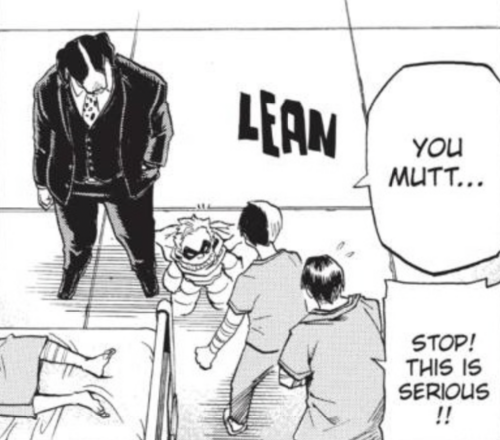
Chapter 56 shows this attitude exactly. Tsuragamae Kenji is the Chief of Police, but when he suggested something that someone found disagreeable, he is quickly disrespected and called a 'mutt' (in the original Japanese, 「この犬…」 "this dog...").
This would probably be considered a microaggression, calling someone with an animal-heteromorphic-quirk an animal. The first instance of microaggression in the manga is actually in Chapter 6, in which Shoji is asked if he's an 'gorilla' or 'octopus'. This was actually addressed as such in Chapter 371! The next instance is Chapter 21, in which Officer Sansa is subjected to the stereotype of... not being a police dog, I guess?)

They're just microaggression, words that come and go, perhaps, but the attitudes that give microaggression space to exist stem from the same place as anti-acceptance on the level of denying accessibility.
The examples of anti-acceptance so far talked about in this post is relatively minor, and actually just hinted at. However, in Chapter 57, we are given a rather extreme example of body modification in order to fit the 'norm'. In Chapter 57, we meet Daikaku Miyagi, whose appearance is very notable in that one of his horns look like it was cut off. Turns out, that's exactly what happened.

Daikaku Miyagi was praised this deed, as it was considered being considerate of his TV audiences . It's true this is a personal decision, and he can do whatever he feels is best for him, but one has to wonder about why instead of news stations accommodating easily editable visual presentations, the fix is chopping off a healthy body part.
The extra notes that describe his situation calls it 'rejection of Quirks'. In the same chapter, Gran Torino calls the current era "an age of suppression". Rejection, suppression - we are shown that this is a quirk society that hasn't actually embraced and accommodated quirks. Rather, quirk use is banned and a norm is defined that everyone is encouraged to follow. That seems simple enough when your quirk is an emitter that you can just not emit from your body.
So what happens when your quirk *is* your body? Which brings up questions of how heteromorphs live in such a society. Is using an extra appendage quirk use? If you have a full-body heteromorphic quirk and you get in a tussle in the heat of the moment, is that regular assault or is quirk use added onto the charges? People with quirks that gives them a 'scary' heteromorphic appearance - is that why it looks like these kind of people dominate the role of villains? The first Villain the reader ever sees in the manga is a heteromorph (the purse-snatcher). As is the second (Sludge Villain). Most of the crowd of Villains that Shigaraki brings to invade UA seems to be heteromorphs, actually.
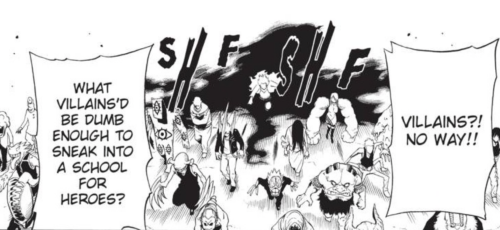
One or two heteromorphic villains is just two randos running around. When it becomes a pattern that most Villains in HeroAca seem to be heteromorphs, the 'why' needs to be asked and a cause identified. Is it because they feel suppressed, as Gran Torino says? Rejected because of their appearance and quirks? If being a heteromorph means a higher chance of receiving microaggressions and being excluded from society - pushed to the margins, and left to do questionable things to survive - and a high chances of falling into Villainy, there is probably an societal problem.
All this is in the first 100 chapters. Similar to the development of Villains and the causes of that villany, the issue that heteromorphs face isn't focused on - they're scary looking villains, the issues brought up about Hero Society is vaguely implied. Horikoshi himself said he didn't expand on the Villains much at first on purpose because he wanted them unknowable and scary.
Of course, I would say Heteromorph Discrimination is a subsection within a larger category of Quirk Discrimination. Or maybe in-universe, this can be a type of 'intersectionality'. Toga's backstory in Chapter 227 is the failure of quirk counseling, but as we see in Chapter 370, about 150 chapters after Chapter 227, quirk counseling has also failed heteromorphs because it's 'one size fits all' simply was not equip to deal with the inherent variability of heteromorphic quirks. Meanwhile, the concept of 'kegare' - impurity - that's first introduced by the CRC in Chapter 220 and expanded on in Shouji's backstory recently in Chatper 371, being a base for why heteromorphs are hated in the countryside - that they defile the land and taint others - is also something that can apply to quirks like Shigaraki's and Toga's: decay/death and blood are things that would be considered 'impure' and thus avoided.
In anycase, throughout the manga, we're give subtle, background examples of issues heteromorphs face, like accessibility, dehumanization, making up a higher proportions of villains. Altogether, it pointed to plain discrimination, of which a lifetime of experiencing can wear a person hollow. To quote Shigaraki/Tenko, "it built up...little by little, over time". And then it exploded, but the fuse had been slowly burning for quite a while.
My theory about what happened to Touya is pretty much the same as yours - he attempted to do something dangerous with his quirk and burned alive for it. As to reason for it, I don't know. I do think, however, that it WASN'T during training, and I don't think Endeavor trained him at all after it became clear that he was "defective" - what would he gain from it. From what we see of the flashbacks, Touya was a healthy kid that played with his siblings.
I agree. The timeline doesn’t seem to work out that way.
We know that while Touya had a powerful fire quirk, his body was too weak for it.

So Endeavor must have given up on training him already at a young age and went on to have other children: Fuyumi, (unless twin theory, which I think it’s quite plausible given Endeavor’s and the other kids’ age), Natsuo and Shouto.

Here is Shouto at five, pre-scar, not allowed to play with his siblings - and Touya is still among them. Endeavor clearly only training him.
Keep reading
"Heroes can't save everyone" We already knew this! Repeating what we already knew isn't a satisfactory conclusion to anything.
If Ochako started off as naive girl who thought that everything will work out in the end, then coming to terms with the realities of heroism could have been a fitting ending. But that is not her story at all! Ochako's arc was kick started after carrying dying Nighteye in her arms. She is well aware that heroes can't save everyone. Because naivety wasn't her character flaw, the failure to save Toga doesn't develop her character in any way nor does it showcase her growth as a person. And it's not meaningful for the story to end with an answer to something that was never the question. Her character flaws were the sense of powerlessness and emotional suppression. Saving Toga in a confrontation of raw emotion would have broken her out of that suppression and helplessness and thus would have been a powerful culmination of her character.
Secondly, we already had "Heroes can't save everyone" when Hawks failed to reach out to Twice. The death of Twice made Toga question what Ochako wants to do to her. I thought that was set up for the cycle of violence to be broken by the new generation. Apparently not. Toga dying despite Ochako doing everything right, coupled with the fact that Tomura died and Dabi is dying too, makes it feel like heroes cannot save those who have fallen through the cracks, no matter what. Isn't that just awful?
Ochako's arc ends with the person she wanted to save dying in her arms. Again. The hero failed to save the villain. Again. On top of all that, the poor girl is suppressing her feelings. Again.
It's redundant and unsatisfying. Makes it feel like we didn't progress at all - just repeating the old failures.
Also I don't want to hear about gritty realism when this manga has this fucking thing lmao

In the same chapter where Ochako has a breakdown over Toga apparently dying from blood transfusion no less. Unhinged.
Stickers project !!!!

Sorry I just can’t draw spinner, he is super ugly in this style and I don’t really know how to draw reptilian characters😔💔










